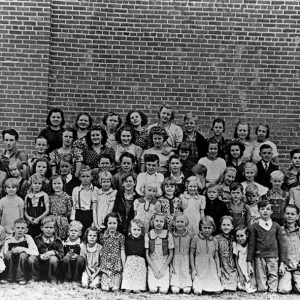calsfoundation@cals.org
Blue Eye (Carroll County)
| Latitude and Longitude: | 36°29’52″N 093°23’53″W |
| Elevation: | 1,289 feet |
| Area: | 0.07 square miles (2020 Census) |
| Population: | 46 (2020 Census) |
| Incorporation Date: | March 4, 1932 |
Historical Population as per the U.S. Census:
|
1810 |
1820 |
1830 |
1840 |
1850 |
1860 |
1870 |
1880 |
1890 |
1900 |
|
– |
– |
– |
– |
– |
– |
– |
– |
– |
– |
|
1910 |
1920 |
1930 |
1940 |
1950 |
1960 |
1970 |
1980 |
1990 |
2000 |
|
– |
– |
– |
– |
– |
69 |
53 |
43 |
38 |
36 |
|
2010 |
2020 |
|
|
|
|
|
|
|
|
|
30 |
46 |
|
|
|
|
|
|
|
|
The town of Blue Eye in Carroll County has two distinctions: it is the northernmost community in Arkansas and also has the smallest population of any incorporated community in Arkansas. Like Texarkana (Miller County) and Junction City (Union County), Blue Eye is actually made up of two communities straddling a state line. At the time of the 2020 census, on the Arkansas side, Blue Eye was a town with forty-six residents, and, in Missouri, it was a village with 289 residents.
A highway called the Wilderness Road ran through the area before the Civil War. The Butler, Pitman, Craven, and Rhodes families lived along the road, and the region along the state line was known as Butler’s Barrens. During the Civil War, the region was abandoned, but Elbert Butler, among others, returned after the war to resettle the area. Butler received permission to open a post office on the Missouri side of the community in 1870; it is said that the name Blue Eye was given to the post office because of Butler’s notable blue eyes. Isaac Newman acquired land in Arkansas near the state line in 1895, and he was joined by John Hutchinson and George Hutchinson in 1897.
The community developed with a public square surrounded by several stores. A Baptist congregation was formed in 1883. In 1916, the congregation began to organize a mountain mission school; it received $4,500 from the Mission Board of the Southern Baptist Convention and built a two-story schoolhouse in the Arkansas portion of Blue Eye. The school opened for classes in 1918. Two dormitories were added by 1920. Known variously as Montview Institute, Carroll County Institute, Mo-Ark Baptist Academy, Armo Baptist Academy, and Armoka, the school had grown to support a faculty of five teachers by 1929 and was known for its successful baseball and basketball teams. The academy closed in 1931 after a public high school was opened in Missouri a mile north of Blue Eye. Huskey (Carroll County) and Red Bank (Carroll County) schools were consolidated into District Ten, which became known as Blue Eye and used the academy building.
The Wilderness Highway was designated State Highway 21 during the 1920s and was paved in the 1930s. The Arkansas side of Blue Eye incorporated as a town in 1932.
Later, the Green Forest (Carroll County) school district absorbed the Blue Eye school district and used the school building there as an elementary school until the 1950s. Since then, children from Blue Eye have been transported to Green Forest for classes. The academy building was given to the town of Blue Eye and was used for a while as a community center, but the building’s deterioration, along with vandalism, led the town government to consider razing the structure by the end of the 1970s. Instead, the roof was repaired and new windows were installed, but vandalism continued to plague the building. Blue Eye mayor Annalea Tharp raised money to preserve the building, which was added to the National Register of Historic Places in 1996.
By 1998, the Arkansas side of Blue Eye had one grocery store and a park. Residents worked at Tyson poultry plants in Green Forest and Berryville (Carroll County). The town’s annual budget was estimated at about $1,000, although it rose to $3,000 in 1997 when the community bought a lawn mower.
By 2015, all the businesses of Blue Eye were in the Missouri portion of the community, including a liquor store just over the state line; the Baptist church remained active in Blue Eye, Arkansas.
For additional information:
Carroll County Historical and Genealogical Society. The History and Families of Carroll County, Arkansas. Paducah, KY: Turner Publishing Company, 2003.
Cofer, Brian. “Residents’ Sweat, Arm-Twisting Help Tiny Towns Survive.” Arkansas Democrat-Gazette, June 1, 1998, p. 1B.
“History of Mo-Ark Academy.” Carroll County Historical Quarterly 51 (December 2006): 49.
Lair, Jim. An Outlander’s History of Carroll County, Arkansas, 1830–1983. Marceline, MO: Walsworth Publishing Company, 1983.
Steven Teske
Butler Center for Arkansas Studies
 Blue Eye School
Blue Eye School  Carroll County Map
Carroll County Map 



Are there any stores or anything in Blue Eye, Arkansas, in 2024?